Accepted Scientific Name: Coryphantha macromeris (Engelm. in Wisliz.) Lem.
Cactées 35. 1868 [Aug 1868]
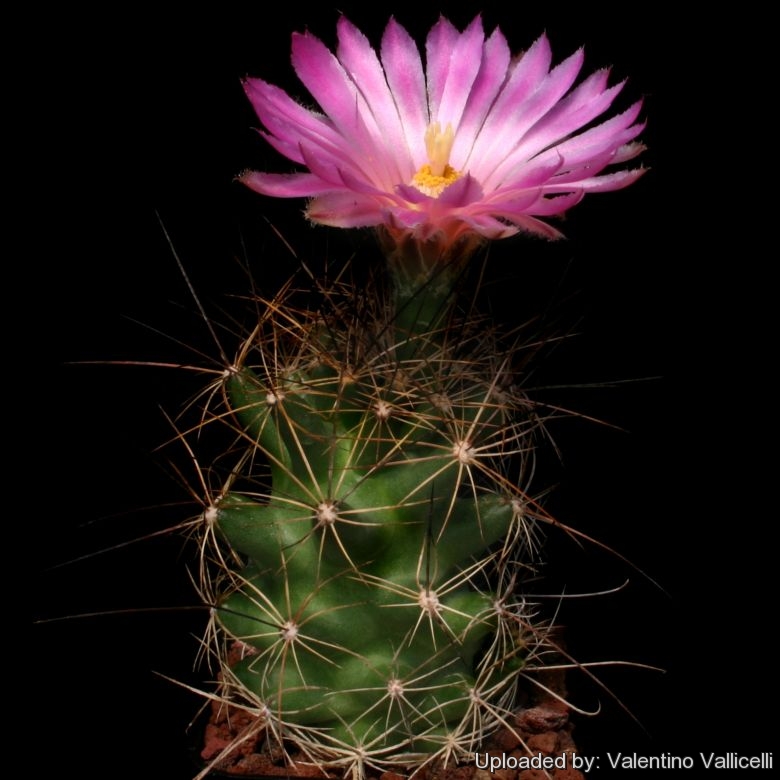
Lepidocoryphantha macromeris (Coryphantha macromeris) Photo by: Valentino Vallicelli
(DJF1353 El Paso, TX. ) It is a hardy cactus with long, dark spines which branches profusely, ultimately forming low mats or hemispheric mounds to 100 cm diameter. The blooms are large bright lavender to magenta over long periods from March to early September.
Origin and Habitat: USA(New Mexico, Texas) and Mexico (hihuahua, Coahuila, Durango, San Luis Potosí, Tamaulipas and Zacatecas). The typical Coryphantha macromerisSN|10268]]SN|10268]] has a very large population comprising many thousands and possibly hundreds of thousands of individuals.
Altitude range: 30-1700(-2000) metres above sea level. Coryphantha macromerisSN|10268]]SN|10268]] has an extremely wide range and is very abundant. The subspecies runyonii has a much smaller range.
Habitat and ecology: Coryphantha macromerisSN|10268]]SN|10268]] has a wide range in the Chihuahuan Desert growing nearly in all substrates including nearly pure gypsum, gravelly soils, usually sandy alluvium or clay, especially in dry river lagoon areas, rarely crevices or steep slopes. It grows out in the open or under bushes. It also grows in pure gypsum and in gravelly soils. Both subspecies are not considered to be threatened.
Synonyms:
See all synonyms of Coryphantha macromeris
Common Names include:
ENGLISH: Long Mamma Foxtail-Cactus, Big Needle Cactus, Big Nipple Cory-Cactus, Long Mamma, Nipple Beehive Cactus, Dona Ana
SPANISH (Español): Doña Ana, Biznaga-Partida, Doñana
TARAHUMARA: Dona-ra
Description: Plants profusely branched with long projecting spines, ultimately forming low mats or hemispheric mounds to 100 cm diameter. Coryphantha macromerisSN|10268]]SN|10268]] comprises two subspecies - the typical form and subsp. runyonii (Britton & Rose) N.P.Taylor.
Stem: Noticeably tuberculate, hemispheric to short cylindrical, sometimes obscured by profusion of immature branches, 4-12 cm; tubercles unusually large 15-25 mm and grooved only on the upper half, flaccid or flabby; areolar glands seasonally conspicuous.
Root: It has deep succulent taproot often massive and large.
Spines: Weakly appressed or projecting, slightly curved, often flexible. Radial 9-15 per areole, white, grey, tan, or brown, 15-25 mm long; subcentral spines 2-3 in adaxial part of areole; central spines 3-8 per areole, pale grey to black, abaxial central spine porrect or descending.
Flowers: Apical or nearly so at mid-level of tubercle, outer tepals heavily fringed; flower bright rose-pink or magenta, often with darker midstripes and paler margins
Fruits: Dark green, ovoid to obpyriform or ellipsoid.
Remarks: The flowers of Coryphantha macromerisSN|10268]]SN|10268]] are virtually identical to those of Mammillaria wrightiiSN|9411]]SN|9411]] and Escobaria viviparaSN|9953]]SN|9953]]; in the absence of vegetative material, flowers may be unidentifiable.
Subspecies, varieties, forms and cultivars of plants belonging to the Coryphantha macromeris group
 Coryphantha macromeris (Engelm. in Wisliz.) Lem.: (subsp. macromeris) has green stems up to 15 cm tall and tubercles up to 15 mm long. Distribution: USA(New Mexico, Texas) and Mexico (hihuahua, Coahuila, Durango, San Luis Potosí, Tamaulipas and Zacatecas).
Coryphantha macromeris (Engelm. in Wisliz.) Lem.: (subsp. macromeris) has green stems up to 15 cm tall and tubercles up to 15 mm long. Distribution: USA(New Mexico, Texas) and Mexico (hihuahua, Coahuila, Durango, San Luis Potosí, Tamaulipas and Zacatecas). Coryphantha macromeris subs. runyonii (Britton & Rose) N.P.Taylor: has gray-green stems up to only 7.5 cm tall and tubercles up to 7.5 mm long; It is found near sea level on the plain of the Rio Grande.
Coryphantha macromeris subs. runyonii (Britton & Rose) N.P.Taylor: has gray-green stems up to only 7.5 cm tall and tubercles up to 7.5 mm long; It is found near sea level on the plain of the Rio Grande.
Notes: Coryphantha macromerisSN|10268]]SN|10268]] pass several stages of development in which their appearance changes and stunted or immature plants are variable, often have only 5-7 radial spines and lacking central spines. It has strongly mucilaginous cortex even small slices of living tubercle tissue are visibly and tangibly slimy.
Bibliography: Major references and further lectures
1) Heil, K., Terry, M., Corral-Díaz, R., Lüthy, A.D. & Dicht, R.F. 2013. Coryphantha macromeris. The IUCN Red List of Threatened Species 2013: e.T152811A681352. http://dx.doi.org/10.2305/IUCN.UK.2013-1.RLTS.T152811A681352.en. Downloaded on 04 April 2016.
2) John Pilbeam (1999) “Mammillaria The Cactus File Handbook” Nuffield Press.
3) Edward F. Anderson “The Cactus Family” Timber Press, 2001
4) James Cullen, Sabina G. Knees, H. Suzanne Cubey “The European Garden Flora Flowering Plants: A Manual for the Identification of Plants Cultivated in Europe, Both Out-of-Doors and Under Glass” Cambridge University Press, 11/August/2011
5) Nathaniel Lord Britton, Joseph Nelson Rose “Cactaceae: Descriptions and Illustrations of Plants of the Cactus Family” vol. 4 The Carnegie Institution of Washington, Washington 1923
6) Benson, L. “The Cacti of the United States and Canada.” Stanford University Press, Stanford, California. 1982
7) Dicht, R.F. and Lüthy, A.D. “Coryphantha Cacti of Mexico and Southern USA.” Springer-Verlag, Berlin. 2003
8) David Hunt, Nigel Taylor “The New Cactus Lexicon” DH Books, 2006
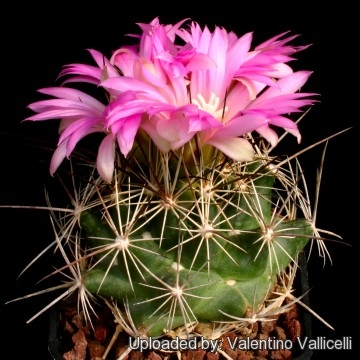 Lepidocoryphantha macromeris (Coryphantha macromeris) Photo by: Valentino Vallicelli
Lepidocoryphantha macromeris (Coryphantha macromeris) Photo by: Valentino Vallicelli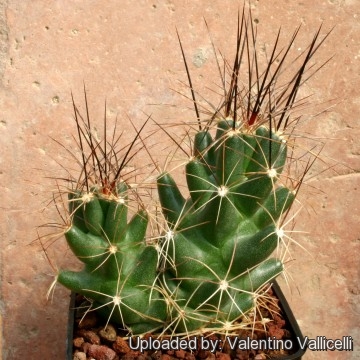 Lepidocoryphantha macromeris (Coryphantha macromeris) Photo by: Valentino Vallicelli
Lepidocoryphantha macromeris (Coryphantha macromeris) Photo by: Valentino Vallicelli Lepidocoryphantha macromeris (Coryphantha macromeris) Photo by: Diego Armentano
Lepidocoryphantha macromeris (Coryphantha macromeris) Photo by: Diego Armentano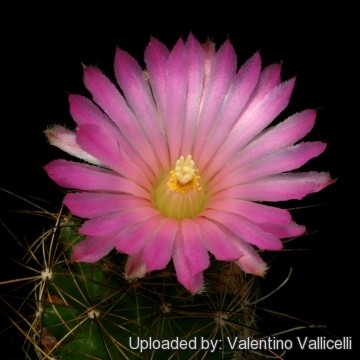 Lepidocoryphantha macromeris (Coryphantha macromeris) Photo by: Valentino Vallicelli
Lepidocoryphantha macromeris (Coryphantha macromeris) Photo by: Valentino Vallicelli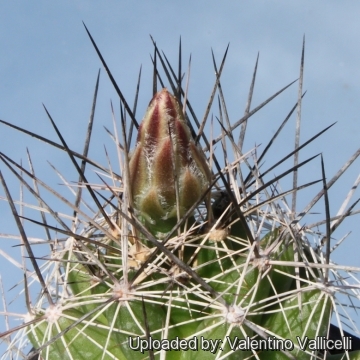 Lepidocoryphantha macromeris (Coryphantha macromeris) Photo by: Valentino Vallicelli
Lepidocoryphantha macromeris (Coryphantha macromeris) Photo by: Valentino Vallicelli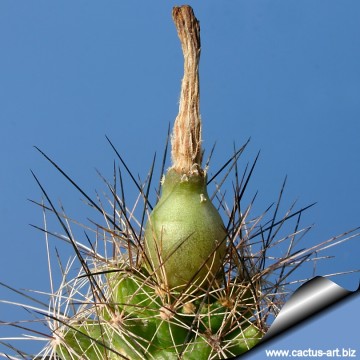 Lepidocoryphantha macromeris (Coryphantha macromeris) Photo by: Cactus Art
Lepidocoryphantha macromeris (Coryphantha macromeris) Photo by: Cactus Art Lepidocoryphantha macromeris (Coryphantha macromeris) Photo by: Valentino Vallicelli
Lepidocoryphantha macromeris (Coryphantha macromeris) Photo by: Valentino Vallicelli Lepidocoryphantha macromeris (Coryphantha macromeris) Photo by: Valentino Vallicelli
Lepidocoryphantha macromeris (Coryphantha macromeris) Photo by: Valentino VallicelliCultivation and Propagation: Coryphantha macromerisSN|10268]]SN|10268]] is popular with collectors and easy to grow. It comes from an area of summer rainfall. Keep drier in winter (but for outdoor cultivation it is quite resistant to wet conditions, too). Very cold resistant, hardy about to about -10° C, but the frost resistance varies a lot from clone to clone. Needs good drainage. Keep drier in winter, Full sun to partial shade.
Use and Trade: There are reports that Coryphantha macromerisSN|10268]]SN|10268]] (and in particular the subspecies runyonii) is collected for use as a hallucinogen. However, there is some debate about its psychoactive properties as the species does not contain mescaline like peyote, but instead has normacromerine, an analogue of epinephrine which seems to have potential hallucinogenic properties (Anderson 2001). This species may be used ceremonially in Mexico by the Tarahumara.
Propagation: Seeds (no dormancy requirement, they germinate best at 25°C) or by offsets (if available), or occasionally grafted.
Your Photos

by Cactus Art

by Cactus Art
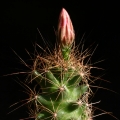
by Valentino Vallicelli
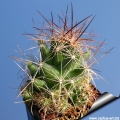
by Cactus Art























